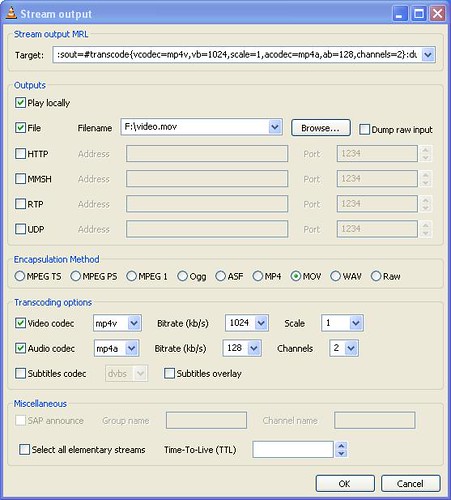This weekend my wife asked me to help her put together some videos for her cooking website. Since I was playing with Adobe Premiere Elements anyways, I thought it would be no problem at all. My outlook changed once she gave me all of the source videos – they were all in DiVX or flash (.FLV) format, and Premiere refused to open them. So I started searching for utilities to convert these files to something Premiere would open.
An hour later I had a bunch of installers on my desktop, but nothing that worked well, or quickly. I decided to give VLC a try. I like VLC as it’s free, opens anything I throw at it, and with the portable version, I always have it available to use wherever I go. When opening a file, stream or disc, you can pick the “stream output” option. I usually save the files as QuickTime .mov files. Here is what the settings window looks like:

Here’s what each of them means:
- Target – ignore this box – VLC will fill it in for you as you make settings in the fields below. If you can fill this box in by hand, you are just one step away from dreaming in binary.
- Play locally – plays the video as you convert it. Checking this box will allow you to see/hear what’s going on. Unchecking it will make the conversion go MUCH faster.
- File – the location of the file you want to save to. Unless you’re overwriting an existing file, you’ll need to make one up.
- Encapsulation method – the type of file you are saving to. Best results come from matching this with the related video & audio codecs below
- Video/Audio codec – the software & algorithm used to compress the audio/video to make it take up less space.
I rarely have to change these settings, but if you’re having an audio problem, you may try changing the audio codec setting.
All of my wife’s files converted flawlessly with VLC, and now I’ve got to figure out all of the differences between Premiere Pro 1.0, which I’ve used at work and Premiere Elements 4.0 that I just installed. With any luck the cooking videos will be done by the end of the week.